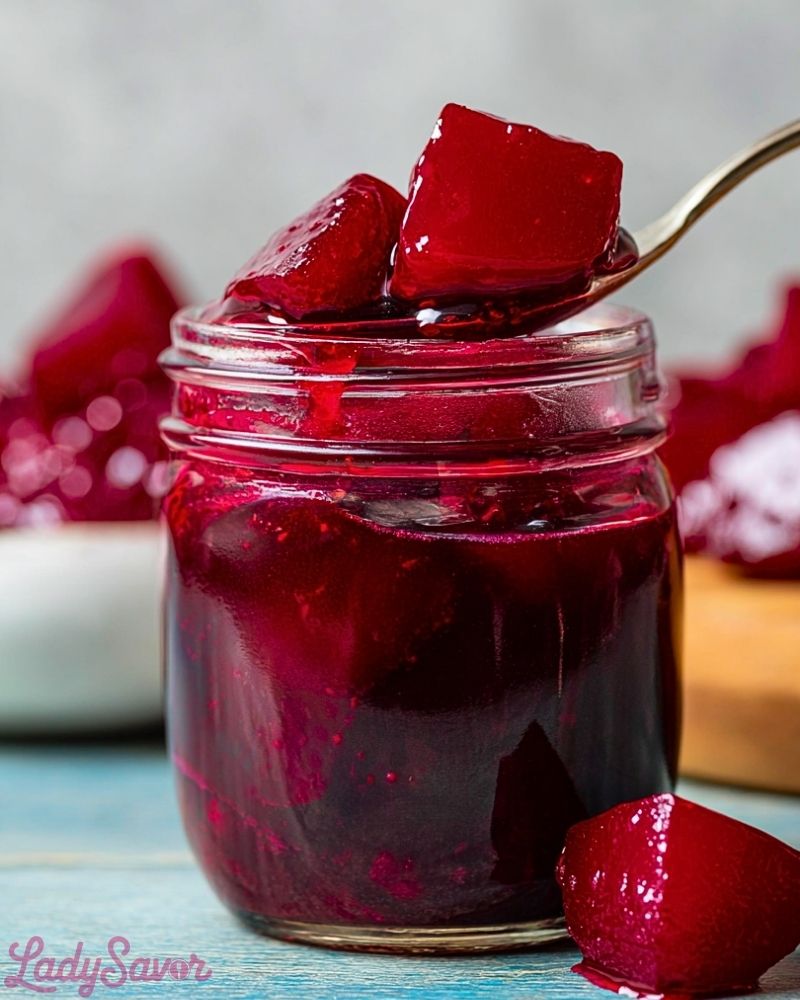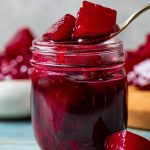Vibrant in color and packed with earthy-sweet flavor, pickled beets are the kind of old-fashioned treat that never goes out of style. Their deep crimson hue and slightly tangy brine make them a delightful side dish, snack, or salad topping. Whether you remember them from your grandmother’s pantry or just discovered their magic at a farmers’ market, this jarred goodness is as nostalgic as it is delicious.

Pickled beets strike the perfect balance between sweet and sour. The tender, roasted beet cubes soak up a vinegar-based brine that’s spiked with spices, sugar, and a touch of salt. The result is a jar full of flavor that keeps for weeks and elevates any meal it touches. Whether served cold on a charcuterie board or layered into a sandwich, these beets are a guaranteed conversation starter.
Why You’ll Love This Pickled Beets Recipe
- Nostalgic & comforting – Brings back memories of homemade meals and traditional canning.
- Naturally vibrant – Their deep red-purple hue is beautiful on any plate.
- Make-ahead magic – Stays fresh for weeks in the fridge.
- Balanced flavor – Sweet, tangy, and slightly spiced for depth.
- Nutrient-rich – Beets are high in fiber, vitamins, and antioxidants.
- Versatile – Perfect in salads, sandwiches, or on their own.
Preparation Phase & Tools to Use (Essential Tools and the Importance of Each Tool)
Getting ready to make pickled beets doesn’t require fancy equipment, but having the right tools will ensure the process is smooth and safe.
- Large Pot or Dutch Oven: This is essential for boiling or roasting the beets until they’re fork-tender. A heavy-bottomed pot distributes heat evenly and reduces the risk of burning.
- Sharp Knife and Cutting Board: Needed for trimming beet tops, peeling, and cubing the cooked beets. A sharp blade ensures clean cuts without crushing the tender flesh.
- Peeler (Optional): Some prefer to peel beets before cooking, although skin removal is easier after roasting or boiling.
- Glass Jars with Lids: Mason jars or other canning jars are ideal for storing your pickled beets. Glass preserves the integrity of the brine and resists staining or reacting with vinegar.
- Medium Saucepan: Used to prepare the pickling brine. This should be non-reactive (like stainless steel) to avoid metallic flavors.
- Funnel (Optional but Helpful): Makes transferring the beets and brine into jars mess-free.
- Gloves: Beets stain! Wearing gloves when peeling and cutting keeps your hands from turning bright pink.
Preparation Tips
- Choose the Right Beets: Look for small to medium beets with smooth skins and no soft spots. They’re typically sweeter and more tender.
- Roast for Richer Flavor: Roasting beets intensifies their sweetness. Wrap in foil and bake at 400°F (204°C) until tender, about 45–60 minutes.
- Boiling Works Too: For a quicker option, boil the beets in water for about 30–40 minutes. Test with a fork for doneness.
- Cool Before Peeling: After cooking, let the beets cool slightly. The skins will slide off easily with a paper towel or your hands.
- Uniform Cuts: Try to cube or slice the beets evenly to ensure consistent flavor absorption in the brine.
- Sterilize Your Jars: Always start with clean, hot jars to ensure food safety and longer shelf life.
Ingredients for This Pickled Beets Recipe
Here’s everything you’ll need to make a batch of classic, sweet-tangy pickled beets:
- 2 pounds fresh beets – trimmed, scrubbed, and cooked (boiled or roasted)
- 1 cup apple cider vinegar – adds the perfect tang and balances the sweetness
- 1 cup water – dilutes the brine so it’s not too harsh
- ½ cup granulated sugar – gives that signature sweetness
- 1 teaspoon salt – enhances all the other flavors
- ½ teaspoon whole black peppercorns – subtle background warmth
- 3 whole cloves – for a traditional, lightly spiced profile
- 1 cinnamon stick (optional) – adds a gentle, earthy sweetness
- 1 small red onion, thinly sliced (optional) – for extra flavor and texture in the jar
Yields about 2 to 3 pint jars, depending on beet size and cut.

Step 1: Prepare and Cook the Beets
Trim the beet greens (leave 1 inch of stem to prevent bleeding) and scrub the beets well. Place them in a large pot, cover with water, and boil for 30–40 minutes, or roast them wrapped in foil at 400°F (204°C) for 45–60 minutes, until fork-tender.
Step 2: Cool, Peel, and Cut
Once cooked, let the beets cool slightly. Peel by rubbing the skins off with your hands or a paper towel. Slice or cube the beets into even-sized pieces, depending on your preference.
Step 3: Prepare the Pickling Brine
In a medium saucepan, combine apple cider vinegar, water, sugar, salt, peppercorns, cloves, and the cinnamon stick (if using). Bring to a boil, then reduce the heat and simmer for 5 minutes to infuse the flavors.
Step 4: Pack the Jars
Divide the sliced or cubed beets evenly into sterilized glass jars. If using, add a few slices of red onion to each jar for flavor and visual appeal.
Step 5: Pour the Brine
Carefully pour the hot brine over the beets in each jar, ensuring all pieces are fully submerged. Leave about ½ inch of headspace at the top.
Step 6: Seal and Cool
Wipe the jar rims clean, seal with lids, and let the jars cool to room temperature. Once cool, refrigerate.
Step 7: Let Them Pickle
Allow the pickled beets to marinate in the refrigerator for at least 24 hours before eating. For best flavor, wait 3–5 days. They’ll stay fresh for up to 3 weeks.
Notes
- Choose fresh, firm beets for the best texture and natural sweetness.
- Don’t skip the rest time – letting the beets sit in the brine for a few days significantly improves the flavor.
- Customize the spices – try adding mustard seeds, bay leaves, or star anise for your own signature twist.
Watch Out for These Mistakes While Cooking
- Overcooking the beets: They should be tender but not mushy. Check with a fork toward the end of cooking time.
- Skipping jar sterilization: This can lead to spoilage or funky flavors. Always start with clean, hot jars.
- Pouring cold brine: The brine must be hot when poured over the beets to help with flavor absorption and safety.
- Cutting uneven pieces: Uneven cuts mean some beets will pickle faster than others, affecting texture and taste.
- Not sealing properly: A loose lid won’t keep your pickles fresh. Make sure jars are sealed tightly before refrigerating.
- Using reactive cookware: Avoid aluminum pots when making the brine—vinegar can react and create a metallic taste.
- Ignoring resting time: Pickled beets need time to absorb flavor. Eating them too soon may lead to disappointment.
- Overloading with spices: A heavy hand with spices can overpower the beets’ natural flavor. Stick to small amounts and adjust with future batches.
What to Serve With Pickled Beets?
Pickled beets are incredibly versatile and can add brightness, texture, and flavor to many dishes. Here’s how to enjoy them beyond just snacking straight from the jar.
8 Recommendations
- Goat Cheese Salad – Crumble goat cheese over arugula or spinach and top with pickled beets for a tangy, creamy balance.
- Grain Bowls – Add them to quinoa or farro bowls with roasted veggies and a lemony dressing.
- Charcuterie Boards – Include pickled beets with cured meats, cheeses, olives, and crackers for a stunning spread.
- Sandwiches & Wraps – Layer them into roasted turkey or grilled veggie sandwiches for a sweet-tart crunch.
- Roast Chicken or Pork – Serve on the side to cut through rich, savory flavors with refreshing acidity.
- Avocado Toast – Slice and place atop creamy avocado toast, finished with cracked pepper and sea salt.
- Deviled Eggs – Garnish your deviled eggs with pickled beet slices or mash some into the filling for color and zing.
- Cold Pasta Salads – Toss into a pasta salad with feta and cucumbers for a refreshing summer side dish.
Storage Instructions
Pickled beets should be stored in clean, airtight glass jars in the refrigerator. Once sealed and chilled, they’ll stay fresh and flavorful for up to 3 weeks. Always use a clean utensil when removing beets to prevent contamination, and make sure the beets remain fully submerged in brine for maximum shelf life and safety.
Note: This recipe is intended for refrigerator pickling, not shelf-stable canning.
Estimated Nutrition (Per ½ cup serving)
- Calories: 70
- Total Fat: 0g
- Saturated Fat: 0g
- Trans Fat: 0g
- Cholesterol: 0mg
- Sodium: 180mg
- Total Carbohydrates: 17g
- Dietary Fiber: 2g
- Total Sugars: 13g
- Added Sugars: 10g
- Protein: 1g
- Vitamin C: 6% DV
- Iron: 4% DV
- Potassium: 260mg
Values are approximate and may vary depending on beet size and brine concentration.
Frequently Asked Questions
1. Can I use pre-cooked or canned beets for this recipe?
Yes! If you’re short on time, pre-cooked vacuum-sealed beets or canned beets (unsalted) work well. Just skip the cooking step and go straight to preparing the brine and pickling.
2. How long do pickled beets last in the fridge?
When stored properly in an airtight jar and fully submerged in brine, they’ll last up to 3 weeks in the refrigerator.
3. Do I need to pressure can or water-bath can these?
Not for this recipe. It’s designed for quick refrigerator pickling only. If you want to make shelf-stable versions, you’ll need a tested canning process and recipe.
4. Why are my pickled beets too soft?
Overcooking the beets during boiling or roasting is often the cause. Beets should be tender but still hold their shape once pickled.
5. Can I reuse the brine?
It’s not recommended. Reusing brine can dilute the flavor and increase the risk of spoilage. For best results, always make a fresh batch.
6. Can I reduce the sugar in the recipe?
You can adjust the sugar to your taste, but reducing it too much may change the preservation quality and flavor balance. Start with a slight reduction and adjust future batches as needed.
7. Are pickled beets good for you?
Yes! Beets are naturally rich in antioxidants, fiber, and essential nutrients. Pickling adds sodium and sugar, so enjoy them in moderation.
8. Why is the brine cloudy?
Cloudiness could indicate contamination or spoilage, especially if accompanied by an off smell. Always use sterilized jars and utensils, and store in the fridge.
Conclusion
Pickled beets are a simple yet rewarding kitchen project that brings together nostalgia, bold flavor, and versatility in a jar. Whether you’re making them for salads, snacks, or sharing with friends, their vibrant color and sweet-tangy kick make them a standout in any meal. With just a few steps and a little patience, you’ll have a homemade treat that tastes like it came straight from Grandma’s pantry.

Sweet, Tangy, and the Jar That Tastes Just Like Grandma’s
- Total Time: 1 hour
- Yield: 2 to 3 pint jars 1x
- Diet: Vegetarian
Description
Sweet, tangy, and deeply nostalgic, these pickled beets capture everything comforting about Grandma’s pantry jars. Whether served with a salad, charcuterie board, or straight from the fridge, this recipe delivers old-school charm with simple ingredients and bold flavor.
Ingredients
2 pounds fresh beets
1 cup apple cider vinegar
1 cup water
0.5 cup granulated sugar
1 teaspoon salt
0.5 teaspoon whole black peppercorns
3 whole cloves
1 cinnamon stick
1 small red onion sliced (optional)
Instructions
1. Trim beet greens, scrub the beets clean, and cook them by boiling for 30–40 minutes or roasting in foil at 400°F for 45–60 minutes until fork-tender.
2. Let the beets cool slightly, then peel by rubbing the skins off. Slice or cube into even pieces.
3. In a saucepan, combine apple cider vinegar, water, sugar, salt, peppercorns, cloves, and cinnamon. Bring to a boil and simmer for 5 minutes.
4. Pack sliced beets and optional red onion into sterilized glass jars.
5. Pour hot brine over beets, covering them completely. Leave 0.5 inch of headspace.
6. Seal jars with lids and let them cool at room temperature before refrigerating.
7. Refrigerate for at least 24 hours before eating, but 3–5 days is best.
8. Enjoy within 3 weeks, keeping beets submerged in brine.
Notes
Let the beets pickle for at least 3 days for the best flavor.
Make sure jars and utensils are clean and sterilized before use.
Roasting the beets gives a deeper, sweeter flavor than boiling.
- Prep Time: 20 minutes
- Cook Time: 40 minutes
- Category: Pickles & Preserves
- Method: Refrigerator Pickling
- Cuisine: American
Nutrition
- Serving Size: 1/2 cup
- Calories: 70
- Sugar: 13g
- Sodium: 180mg
- Fat: 0g
- Saturated Fat: 0g
- Unsaturated Fat: 0g
- Trans Fat: 0g
- Carbohydrates: 17g
- Fiber: 2g
- Protein: 1g
- Cholesterol: 0mg

